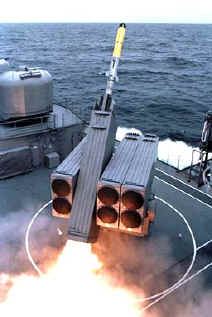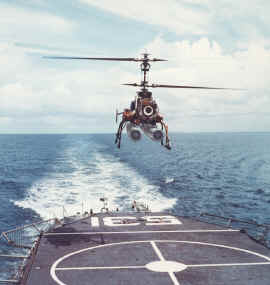The SQS-23 and other Korean-War era sonars, as I mentioned in Part 3, had the capability to detect and track submarines far outside the range of Hedgehog. The US Navy, among others, experimented with larger spigot mortars and rocket-thrown depth charges. Weapon Alpha was one that was largely unsuccessful.
All such weapons had the same problems; there was an unsatisfactory dwell time between the time the rocket was fired and the time the depth charge had sunk to the correct depth and detonated. All of those were predicated on the somewhat ludicrous idea that a submarine commander, knowing that he was being tracked by a destroyer, would hold a steady course and speed.
The answer was ASROC, for "antisubmarine rocket."

As you can see here, ASROC was a rocket which was fired from an eight-cell box launcher. The launcher itself used recycled deck mounts from 3"/50 guns. The rocket itself was a dumb, ballistic, solid-fueled rocket motor. Aiming was done by training the launcher and elevating the two-cell box with the ASROC to be fired. It worked out to be far more accurate than you might think.
On ships with Terrier (later, SM-1/2 ER) launchers (the DDG-37s, CG-16s and CG-26 class ships), ASROC was fired from the missile launcher. Each ASROC loaded was one less Terrier that could be carried. As the main mission of those ships was anti-air warfare, ASROC and ASW were the bastard stepchildren.
The business end of ASROC started out as a Mk.44 torpedo:

The Mk.44s proved to be unsatisfactory (among other things, it was slow) and were fairly rapidly replaced by the Mk.46. The torpedoes were active homers; they had a very high frequency sonar set. For guided weapons, they were the first true "fire and forget" weapons of the surface navy.
For close-in work, the torpedoes were also fired from deck-mounted launchers. Triple-mounts were added to a lot of ships:

The Knox class had twin mounts on either side of the after deckhouse, which were built into the deckhouse just forward of the LAMPS hangar.
ASROC also had a nuclear depth charge variant. This was the only live test, fired in 1962, before the Atmospheric Test Ban Treaty came into effect:
The nuclear ASROC worked like an old rocket-thrown depth charge, but with a hell of a bigger bang. The dumb-rocket version of ASROC left the fleet in the early 1990s when the ships with SM-1/2 ER or box launchers were all retired. A vertical-launch ASROC was eventually developed for use in current warships, though it reportedly was a pretty troubled development program.
ASROC could reach out several miles. But once again, the sensors outranged the weapons. The SQS-26 sonar, through either "bottom bounce" or "convergence zone" modes, could detect and track submarines way the hell out. The first solution was the Drone Anti-Submarine Helicopter, or DASH.
 The concept of operation of DASH was simple: Fly the thing out until the markers from the sonar operator tracking the submarine and from the radar operator tracking the DASH converged, then drop the torpedo. Repeat if necessary (later models of DASH carried two torpedoes), then fly back to the ship for more fuel and torpedoes.
The concept of operation of DASH was simple: Fly the thing out until the markers from the sonar operator tracking the submarine and from the radar operator tracking the DASH converged, then drop the torpedo. Repeat if necessary (later models of DASH carried two torpedoes), then fly back to the ship for more fuel and torpedoes.In practice, DASH didn't work so well. The drones were legendary for crashing and the DASH program was axed.
But that still left the problem that ships could track submarines further out than they could attack them. The answer was to provide ships with manned helicopters, the Kaman Seasprite, SH-2F LAMPS Mk 1:
Late in the 1980s, LAMPS Mk.1 was replaced on the Spruance and Perry class warships by LAMPS Mk.3, which flew the SH-60F. The SH-60 program was supposedly the first aircraft procurement program where the prime contractor was not the airframe manufacturer (Sikorsky), but the electronics package manufacturer (IBM). Those ships were supposed to be able to hold two SH-60s. I never saw more than one LAMPS on a ship at a time and I think I maybe saw one SH-60s.
LAMPS would go out to the location of the submarine as determined by the active sonar track and stream a towed bird that contained a magnetic anomaly detector, the "MAD Bird." There were several different patterns the helo could fly to develop a track on a submarine; once the helo tracked it, it could drop a torpedo.
LAMPS also required a lot of people. The air detachment for LAMPS had three or four pilots and about 20+ sailors, with the senior officer being the head of the Air Department. More than one ensign or JG division officer in the other departments had more sailors and equipment to maintain than those four officers in LAMPS, which lead to the standard complaint of: "I know what they do to earn their flight pay, but what do they do to earn their base pay?" The corrosion control program for the helos required that they be frequently washed with fresh water (the fresh water usage of the LAMPS detachment routinely led to the Chief Engineer threatening violence upon the Air Boss).
LAMPS pilots were certifiable. Take a look at the photo of this Knox-class FF and note the size of the flight deck:
Now imagine trying to land a helicopter on that deck, at night, with the wind burbling around the superstructure and the ship rolling a bit. The LAMPS pilots did that, and the flight deck on a Garcia class FF was even smaller. They had to be nuttier than a jar of Planter's.
LAMPS became even more important when surface ships began to be fitted with towed array passive sonars (TACTASS, for Tactical Towed-Array Sonar System). If conditions were right, a towed array could be towed below the thermocline layer, down where submarines could hide from the hull-mounted sonars of ships. LAMPS were fitted with a launcher that fired off sonobuoys; little floats that dropped hydrophones deep into the water. The buoys had radio transmitters that send the signals to the LAMPS helo, which relayed them to the ship's sonar shack, where the signals were printed out on a frequency analyzer that was surplused from the P-3C upgrade program.
Sonobuoys came in several flavors. The ships had to pay for them and, as the ones with dumb omnidirectional hydrophones were the cheapest, those were the one used the most. There were sonobuoys with active pingers, but they were both costly and, as they alerted a sub that it was being hunted, not preferred.
Sonobuoys were used to localize a contact gained from the towed array. Once the contact was localized, the LAMPS helo would be vectored in for a MAD search. Once the helo had a MAD contact, then it was up to the three crewmen in the helo (two pilots and a sensor operator) to gain an attack solution and kill the submarine.



















